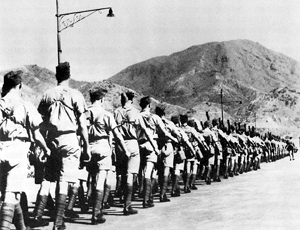Combat uniform
Combat uniform refers to the standard military uniform that members of the armed forces wear during combat operations. Designed for durability, protection, and camouflage, combat uniforms have evolved significantly over time to incorporate advanced materials and technology. They are distinct from dress uniforms, which are worn during ceremonial occasions.
History[edit | edit source]
The concept of a combat uniform dates back to ancient civilizations, where soldiers wore specific attire to distinguish themselves from the enemy. However, the modern combat uniform began to take shape in the 19th century, with the introduction of uniforms designed for specific military functions and environments. The 20th century saw rapid advancements in materials and camouflage techniques, influenced by the two World Wars and subsequent conflicts.
Components[edit | edit source]
A typical combat uniform consists of several components, each designed for functionality and protection on the battlefield.
Jacket and Trousers[edit | edit source]
The jacket and trousers are usually made of durable, rip-stop fabric, with patterns or colors selected for camouflage in specific environments, such as woodland, desert, or urban areas.
Headgear[edit | edit source]
Headgear varies by country and mission, including items such as helmets for protection and boonie hats or patrol caps for camouflage and sun protection.
Footwear[edit | edit source]
Military boots are designed for durability and to protect the feet in various terrains, from desert sands to jungle floors.
Load-Carrying Equipment[edit | edit source]
This includes vests, belts, and harnesses designed to carry ammunition, water, and other essential gear.
Body Armor[edit | edit source]
Modern combat uniforms may be worn with body armor to protect against ballistic threats.
Camouflage[edit | edit source]
Camouflage is a critical aspect of the combat uniform, designed to conceal soldiers from the enemy. Patterns and colors are chosen based on the operational environment, and there has been a trend towards digital camouflage patterns, which are designed to be more effective across a variety of environments.
Technological Advancements[edit | edit source]
Recent advancements in combat uniform technology include the integration of nanotechnology for improved durability and protection, moisture-wicking fabrics to keep soldiers dry, and even uniforms capable of monitoring a soldier's health status.
Global Variations[edit | edit source]
There is significant variation in combat uniforms globally, with each country developing patterns and designs suited to their environment and tactical needs. Some countries have multiple patterns for different environments, while others have a single, multi-environment pattern.
Future Trends[edit | edit source]
The future of combat uniforms includes the development of smart fabrics capable of adapting to environmental changes, providing camouflage, or even generating power for electronic devices.
Search WikiMD
Ad.Tired of being Overweight? Try W8MD's physician weight loss program.
Semaglutide (Ozempic / Wegovy and Tirzepatide (Mounjaro / Zepbound) available.
Advertise on WikiMD
|
WikiMD's Wellness Encyclopedia |
| Let Food Be Thy Medicine Medicine Thy Food - Hippocrates |
Translate this page: - East Asian
中文,
日本,
한국어,
South Asian
हिन्दी,
தமிழ்,
తెలుగు,
Urdu,
ಕನ್ನಡ,
Southeast Asian
Indonesian,
Vietnamese,
Thai,
မြန်မာဘာသာ,
বাংলা
European
español,
Deutsch,
français,
Greek,
português do Brasil,
polski,
română,
русский,
Nederlands,
norsk,
svenska,
suomi,
Italian
Middle Eastern & African
عربى,
Turkish,
Persian,
Hebrew,
Afrikaans,
isiZulu,
Kiswahili,
Other
Bulgarian,
Hungarian,
Czech,
Swedish,
മലയാളം,
मराठी,
ਪੰਜਾਬੀ,
ગુજરાતી,
Portuguese,
Ukrainian
Medical Disclaimer: WikiMD is not a substitute for professional medical advice. The information on WikiMD is provided as an information resource only, may be incorrect, outdated or misleading, and is not to be used or relied on for any diagnostic or treatment purposes. Please consult your health care provider before making any healthcare decisions or for guidance about a specific medical condition. WikiMD expressly disclaims responsibility, and shall have no liability, for any damages, loss, injury, or liability whatsoever suffered as a result of your reliance on the information contained in this site. By visiting this site you agree to the foregoing terms and conditions, which may from time to time be changed or supplemented by WikiMD. If you do not agree to the foregoing terms and conditions, you should not enter or use this site. See full disclaimer.
Credits:Most images are courtesy of Wikimedia commons, and templates, categories Wikipedia, licensed under CC BY SA or similar.
Contributors: Prab R. Tumpati, MD




